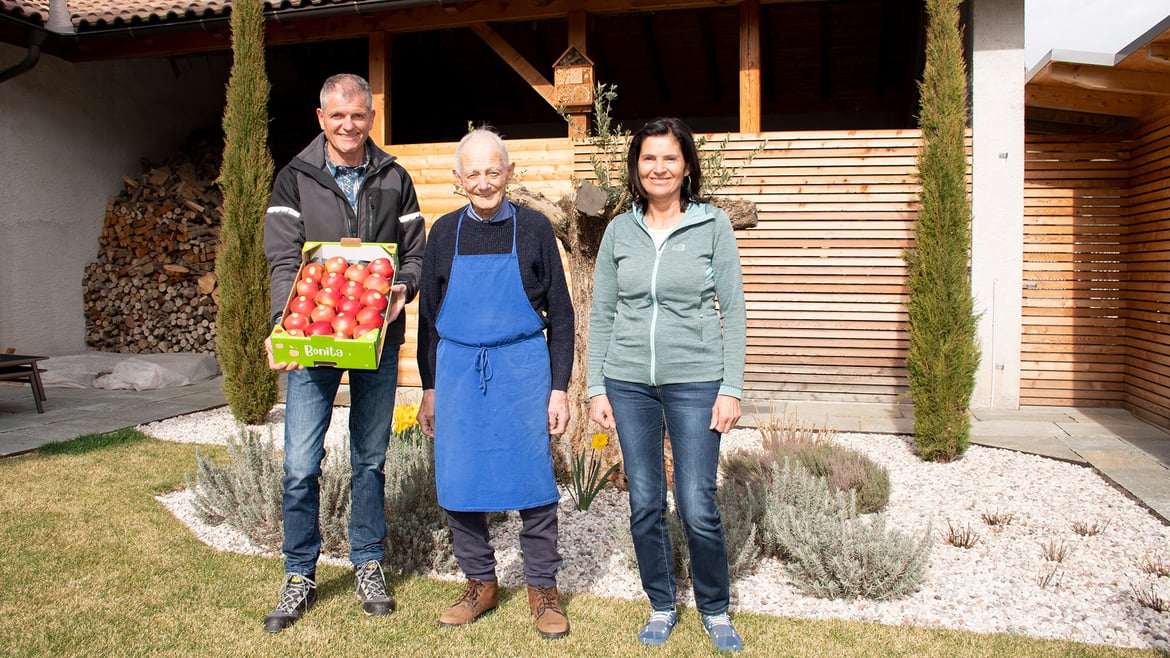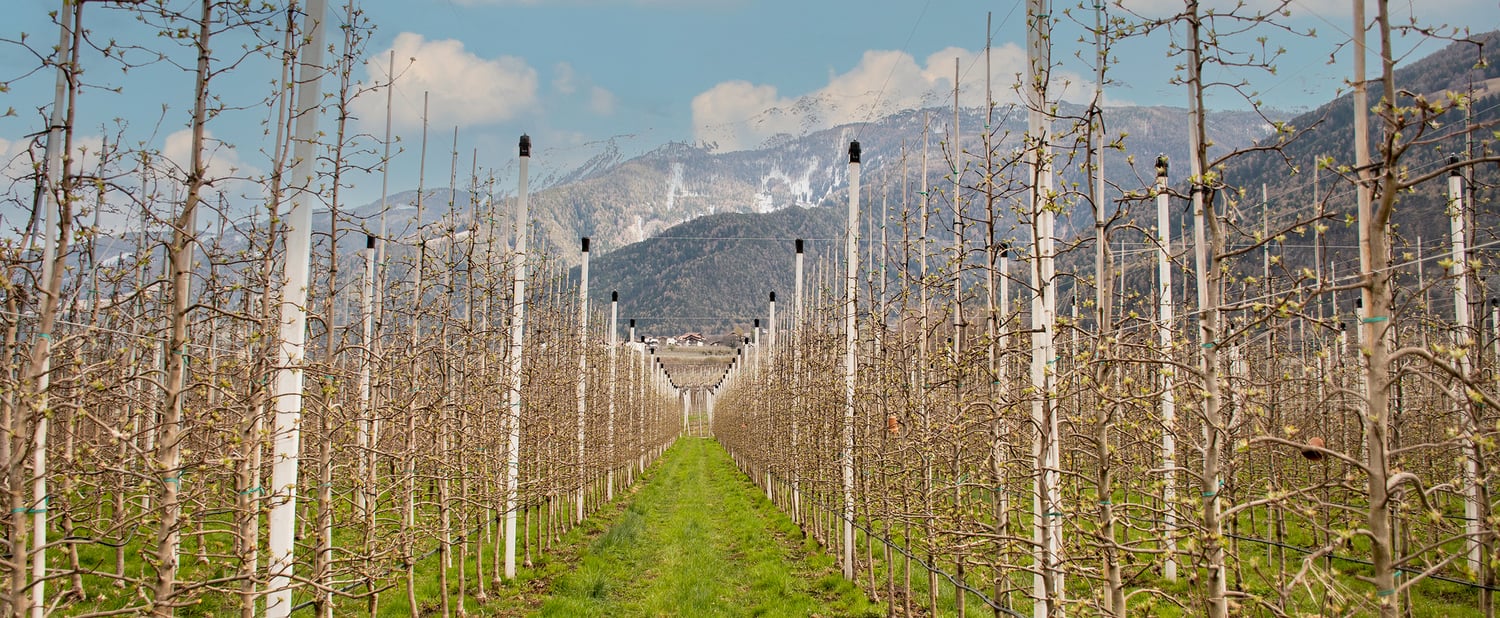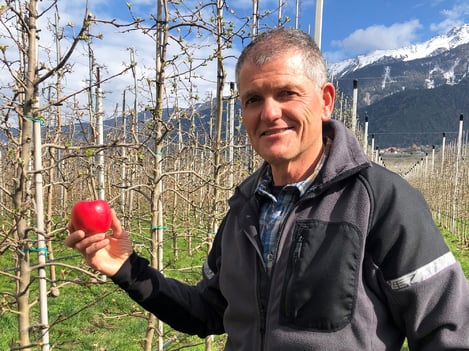Egon Maringgele from the "Brugghof " was one of the first apple growers in Ciardes to sign up on the "waiting list" of their cooperative to purchase little trees of the beloved Bonita apple variety. This variety is particularly resistant to the scab fungus. Since 2007, Egon has been cultivating his farm according to the guidelines of "Bioland", the renowned cultivation association in the organic food sector, and the cultivation of scab-resistant varieties is therefore implemented gradually and consistently.
Today, after already four successful harvests with the approx. 1,000 young trees of the very robust apple variety Bonita, Egon continues to dream with this red-faced fruit. He now rightly feels like a kind of "specialist" of this variety. His enthusiasm still burns intensely, just as intensely as the red skin colour of the magnificent and voluminous fruit. This year, Egon plans to plant another 2,100 little Bonita trees. Just like five years ago, he is hoping for a good lot with the plants he has bought. "Hopefully there will be many trees with premature shoots among them. Then you can enjoy a nice yield already in the second year. In the first year, the trees are still too weak for that," says Egon.
With hope and confidence, he looks at the soil where the new young trees will soon make themselves comfortable. This will happen in the middle/end of April. Only then will the soil temperature be around 8° Celsius and thus ideal for the young plants to take root quickly. The first 30 centimetres of the top layer of soil are crucial, as this is exactly where the trees form the finest roots. That is why Egon takes most of the soil samples from this area. The soil must be vital and stay vital. The quicker Egon's new Bonita trees will anchor stably in the Val Venosta soil, the better. Then the risk of drying out due to the wind is reduced. The water-saving drip irrigation will then keep the soil moist at the right moment and, God willing, the plants will sprout quickly. It is a very detail-oriented activity every time. Planting requires not only a lot of diligence and patience, but also empathy with the present and future needs of the plant. In doing so, Egon has for many years adhered to the wisdom of an esteemed instructor at the agricultural school. He always stressed the importance of leaving enough space between the trees in the apple row. Only in this way would the trees in the rows behind also receive sufficient sunlight.
"With an optimal row direction (that would be north-south orientation), there is almost no distinction between sun side or shade side in the rows of apple trees. Sometimes, however, this cannot be realised because of the shape of the plot of land. It is then even more important to strive for good cross-lighting between the trees. The farmer must take care of that," Egon explains while looking up to the Val Venosta sun.
The shady side must never be too shady. You orientate yourself on the midday sun and determine the ideal distance between the trees. If you ensure this, one row of apples will never become a darkening "wall" for the other rows.
"My teacher used to say that the farmer must take home a sore sunburn even on the shady side when he does his work in summer and not remain "cheesy" white. Only then does he do everything right and there is enough light in the row!" Egon recalls, smiling melancholically.
This mnemonic from his teacher is much more than just a funny mental reminder for Egon. It gets to the heart of a very complex issue: the Val Venosta farmer can use the warming Val Venosta sun for his own benefit. If he ensures good cross-exposure of the apple rows, he also influences an “optimal ratio” between fruit and leaves. If this ratio is right, the fruits will not only be visually appealing, but also have a wonderful taste. Lots of sun brings lots of flavour. But what exactly does Egon mean by this “optimal ratio”? For this he points to a "fruit skewer", which, however, cannot be eaten. It shows two clusters of flowers garnished with enough foliage. At a later moment the characteristic white flowers will form from them.
"If a blossom has enough company of healthy, green leaves around it, then it will be well nourished by them with their photosynthesis and the fruit from the blossom will be excitingly aromatic right up to the harvest," Egon explains.
Egon measures the aroma of an apple by its high sugar content or, as with the Bonita, by its pronounced acidity and its “green” leading aromas, which are characterised by green banana and kiwi. The slightly unripe fruit aromas of redcurrant and mango, followed by the subordinate finish of sweet elderflower, perfectly round off the sensory profile of Egon's favourite apple, the Bonita. The unique taste of this fruit was the decisive factor for Egon and his wife Sonja to buy more trees of this variety through the cooperative.
"And by the way, Bonita is celebrated as a scab-resistant variety in both organic and integrated fruit growing. It is virtually immune to the scab fungus. With Bonita we do not have to worry too much about its brownish and sometimes even torn sores on leaves and fruits. This even though its bright red skin is by no means tough or thick, but pleasantly soft to penetrate."
Uncomplicated cultivation and low use of pesticides does not mean that the farmer can be lazy. After all, there are enough other fungi besides scab fungi from which the little trees and the fruit must be protected. Besides, aphids & co. are always happy to have a tasty feast in the apple meadow. Like his other colleagues in agriculture, organic farmer Egon counteracts these pests in fruit cultivation with measures aimed at encouraging their natural enemies. Ladybirds and earwigs lead the army of natural antagonists, but many others are active, playing their part in the humus-rich and healthy soil here on the hill of Tablà and forming a harmonious pact with the Val Venosta farmer.
Soon the time will come and the new Bonita trees will be planted. In the meantime, Egon's father Emil is also biting into the inviting fruit from the last harvest in October. At 97 years of age, the juicy and cream-coloured flesh of Bonita is just as much a temptation to him as it is to his son Egon. Both enjoy the tart juices that Bonita's flesh open-heartedly releases.
"This apple is pure beauty in colour and shape. Its crunchiness is not too exaggerated either. In any case, not as firm as the voluptuous apple on the outside would suggest. Even the weaker teeth of an older lad like me can still cope with it." Emil laughs. In "his time" as an active apple grower, the wonderful Bonita did not yet exist. Therefore, the apple veteran almost accompanies his words of praise with a little envy, looking at his son Egon, who was "lucky" enough to be able to grow such a robust apple.
"The boys have it much easier today than we did back then. But I am happy for him. After all, he mostly listened to me and thus did everything right," Emil smiles, looking proudly at his son, who has successfully continued the tradition of the Val Venosta apple farmer. The "imported" olive tree in the garden of the Maringgele family will not distract from this, but only emphasises once more how sun-kissed the alpine Val Venosta valley is. Here, apples can truly contain traces of fresh mountain air and hot mountain sun.






